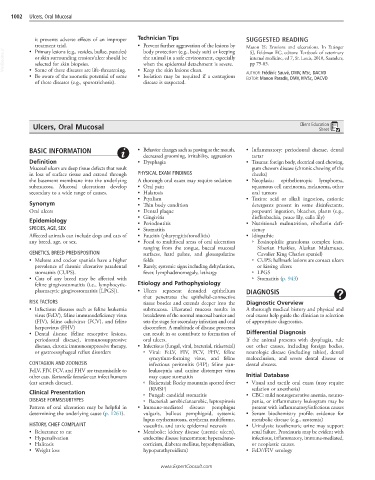Page 2000 - Cote clinical veterinary advisor dogs and cats 4th
P. 2000
1002 Ulcers, Oral Mucosal
it prevents adverse effects of an improper Technician Tips SUGGESTED READING
treatment trial. • Prevent further aggravation of the lesions by Mason IS: Erosions and ulcerations. In Ettinger
VetBooks.ir or skin surrounding erosion/ulcer should be the animal in a safe environment, especially internal medicine, ed 7, St. Louis, 2010, Saunders,
body protection (e.g., body suit) or keeping
• Primary lesions (e.g., vesicles, bullae, pustules)
SJ, Feldman EC, editors: Textbook of veterinary
selected for skin biopsies.
pp 79-83.
when the epidermal detachment is severe.
• Some of these diseases are life-threatening.
• Be aware of the zoonotic potential of some • Keep the skin lesions clean. AUTHOR: Frédéric Sauvé, DMV, MSc, DACVD
• Isolation may be required if a contagious
EDITOR: Manon Paradis, DMV, MVSc, DACVD
of these diseases (e.g., sporotrichosis). disease is suspected.
Ulcers, Oral Mucosal Client Education
Sheet
BASIC INFORMATION • Behavior changes such as pawing at the mouth, • Inflammatory: periodontal disease, dental
decreased grooming, irritability, aggression tartar
Definition • Dysphagia • Trauma: foreign body, electrical cord chewing,
Mucosal ulcers are deep tissue defects that result gum chewers disease (chronic chewing of the
in loss of surface tissue and extend through PHYSICAL EXAM FINDINGS cheeks)
the basement membrane into the underlying A thorough oral exam may require sedation • Neoplasia: epitheliotropic lymphoma,
submucosa. Mucosal ulcerations develop • Oral pain squamous cell carcinoma, melanoma, other
secondary to a wide range of causes. • Halatosis oral tumors
• Ptyalism • Toxins: acid or alkali ingestion, cationic
Synonym • Thin body condition detergents present in some disinfectants,
Oral ulcers • Dental plaque potpourri ingestion, bleaches, plants (e.g.,
• Gingivitis dieffenbachia, peace lily, calla lily)
Epidemiology • Periodontitis • Nutritional: malnutrition, riboflavin defi-
SPECIES, AGE, SEX • Stomatitis ciency
Affected animals can include dogs and cats of • Faucitis (pharyngitis/tonsillitis) • Idiopathic
any breed, age, or sex. • Focal to multifocal areas of oral ulceration ○ Eosinophilic granuloma complex (cats,
ranging from the tongue, buccal mucosal Siberian Huskies, Alaskan Malamutes,
GENETICS, BREED PREDISPOSITION surfaces, hard palate, and glossopalatine Cavalier King Charles spaniel)
• Maltese and cocker spaniels have a higher folds ○ CUPS: hallmark lesions are contact ulcers
prevalence of chronic ulcerative paradental • Rarely, systemic signs including dehydration, or kissing ulcers
stomatitis (CUPS). fever, lymphadenomegaly, lethargy ○ LPGS
• Cats of any breed may be affected with ○ Stomatitis (p. 943)
feline gingivostomatitis (i.e., lymphocytic- Etiology and Pathophysiology
plasmacytic gingivostomatitis [LPGS]). • Ulcers represent denuded epithelium DIAGNOSIS
that penetrates the epithelial-connective
RISK FACTORS tissue border and extends deeper into the Diagnostic Overview
• Infectious diseases such as feline leukemia submucosa. Ulcerated mucosa results in A thorough medical history and physical and
virus (FeLV), feline immunodeficiency virus breakdown of the normal mucosal barrier and oral exams help guide the clinician to selection
(FIV), feline calicivirus (FCV), and feline sets the stage for secondary infection and oral of appropriate diagnostics.
herpesvirus (FHV) discomfort. A multitude of disease processes
• Dental disease (feline resorptive lesions, can result in or contribute to formation of Differential Diagnosis
periodontal disease), immunosuppressive oral ulcers. If the animal presents with dysphagia, rule
diseases, chronic immunosuppressive therapy, • Infectious (fungal, viral, bacterial, rickettsial) out other causes, including foreign bodies,
or gastroesophageal reflux disorders ○ Viral: FeLV, FIV, FCV, FHV, feline neurologic disease (including rabies), dental
syncytium-forming virus, and feline malocclusion, and severe dental disease or
CONTAGION AND ZOONOSIS infectious peritonitis (FIP); feline pan- dental abscess.
FeLV, FIV, FCV, and FHV are transmissible to leukoepnia and canine distemper virus
other cats. Bartonella henselae can infect humans may cause stomatitis Initial Database
(cat scratch disease). ○ Rickettsial: Rocky mountain spotted fever • Visual and tactile oral exam (may require
(RMSF) sedation or anesthesia)
Clinical Presentation ○ Fungal: candidal stomatitis • CBC: mild nonregenerative anemia, neutro-
DISEASE FORMS/SUBTYPES ○ Bacterial: aerobic/anaerobic, leptospirosis penia, or inflammatory leukogram may be
Pattern of oral ulceration may be helpful in • Immune-mediated disease: pemphigus present with inflammatory/infectious causes
determining the underlying cause (p. 1261). vulgaris, bullous pemphigoid, systemic • Serum biochemistry profile: evidence for
lupus erythematosus, erythema multiforme, metabolic disease (e.g., azotemia)
HISTORY, CHIEF COMPLAINT vasculitis, and toxic epidermal necrosis • Urinalysis: isosthenuric urine may support
• Reluctance to eat • Metabolic: kidney disease (uremic ulcers), renal failure. Proteinuria may be evident with
• Hypersalivation endocrine disease (uncommon; hyperadreno- infectious, inflammatory, immune-mediated,
• Halitosis corticism, diabetes mellitus, hypothyroidism, or neoplastic causes.
• Weight loss hypoparathyroidism) • FeLV/FIV serology
www.ExpertConsult.com

